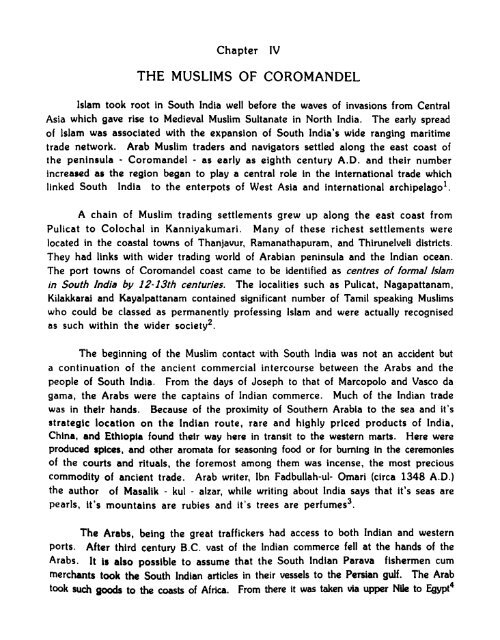maritime activities economy and social customs of the muslims of ...
maritime activities economy and social customs of the muslims of ...
maritime activities economy and social customs of the muslims of ...
Create successful ePaper yourself
Turn your PDF publications into a flip-book with our unique Google optimized e-Paper software.
Chapter IV<br />
THE MUSLIMS OF COROMANDEL<br />
lslam took root in South lndia well before <strong>the</strong> waves <strong>of</strong> invasions from Central<br />
Asia which gave rise to Medieval Muslim Sultanate in North India. The early spread<br />
<strong>of</strong> lslam was associated with <strong>the</strong> expansion <strong>of</strong> South India's wide ranging <strong>maritime</strong><br />
trade network. Arab Muslim traders <strong>and</strong> navigators settled along <strong>the</strong> east coast <strong>of</strong><br />
<strong>the</strong> peninsula - Corom<strong>and</strong>el - as early as elghth century A.D. <strong>and</strong> <strong>the</strong>ir number<br />
increased as <strong>the</strong> region began to play a central role in <strong>the</strong> international trade which<br />
linked South lndia to <strong>the</strong> enterpots <strong>of</strong> West Asia <strong>and</strong> international archipelago1.<br />
A chain <strong>of</strong> Muslim trading settlements grew up along <strong>the</strong> east coast from<br />
Pulicat to Colochal in Kanniyakumari. Many <strong>of</strong> <strong>the</strong>se richest settlements were<br />
located in <strong>the</strong> coastal towns <strong>of</strong> Thanjavur. Ramanathapuram, <strong>and</strong> Thirunelveli districts.<br />
They had links with wider trading world <strong>of</strong> Arabian peninsula <strong>and</strong> <strong>the</strong> lndian ocean.<br />
The port towns <strong>of</strong> Corom<strong>and</strong>el coast came to be identified as centres <strong>of</strong> formal lslam<br />
in South India by 12-13th centuries. The localities such as Pulicat, Nagapattanam,<br />
K~lakkarai <strong>and</strong> Kayalpattanam contained significant number <strong>of</strong> Tamil speaking Muslims<br />
who could be classed as permanently pr<strong>of</strong>essing lslam <strong>and</strong> were actually recognised<br />
as such within <strong>the</strong> wider society2.<br />
The beginning <strong>of</strong> <strong>the</strong> Muslim contact with South lndia was not an accident but<br />
a continuation <strong>of</strong> <strong>the</strong> ancient commercial intercourse between <strong>the</strong> Arabs <strong>and</strong> <strong>the</strong><br />
people <strong>of</strong> South India. From <strong>the</strong> days <strong>of</strong> Joseph to that <strong>of</strong> Marcopolo <strong>and</strong> Vasco da<br />
gama, <strong>the</strong> Arabs were <strong>the</strong> captains <strong>of</strong> lndian commerce. Much <strong>of</strong> <strong>the</strong> lndian trade<br />
was in <strong>the</strong>ir h<strong>and</strong>s. Because <strong>of</strong> <strong>the</strong> proximity <strong>of</strong> Sou<strong>the</strong>rn Arabia to <strong>the</strong> sea <strong>and</strong> it's<br />
strategic locatlon on <strong>the</strong> lndian route, rare <strong>and</strong> highly priced products <strong>of</strong> India,<br />
China, <strong>and</strong> Ethiopia found <strong>the</strong>ir way here in transit to <strong>the</strong> western marts. Here were<br />
produced splces, <strong>and</strong> o<strong>the</strong>r aromata for seasoning food or for burning in <strong>the</strong> ceremonies<br />
<strong>of</strong> <strong>the</strong> courts <strong>and</strong> rituals, <strong>the</strong> foremost among <strong>the</strong>m was incense, <strong>the</strong> most precious<br />
commodity <strong>of</strong> ancient trade. Arab writer, Ibn Fadbullah-ul- Omari (circa 1348 A.D.)<br />
<strong>the</strong> author <strong>of</strong> Masallk - kul - alzar, while writing about lndia says that it's seas are<br />
pearls, it's mountains are rubies <strong>and</strong> it's trees are perfumes3.<br />
The Arabs, being <strong>the</strong> great traffickers had access to both lndian <strong>and</strong> western<br />
ports. After third century B.C. vast <strong>of</strong> <strong>the</strong> lndian commerce fell at <strong>the</strong> h<strong>and</strong>s <strong>of</strong> <strong>the</strong><br />
Arabs. It Is also possible to assume that <strong>the</strong> South lndian Parava fishermen cum<br />
merchants took <strong>the</strong> South Indian articles in <strong>the</strong>ir vessels to <strong>the</strong> Persian gulf. The Arab<br />
took such goods to <strong>the</strong>! coasts <strong>of</strong> Africa. From <strong>the</strong>re it was taken via upper Ni to Egypt4

















